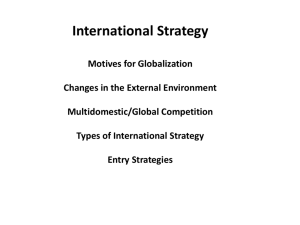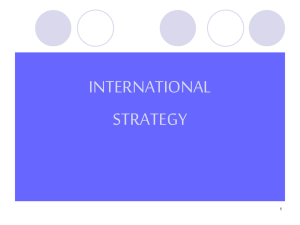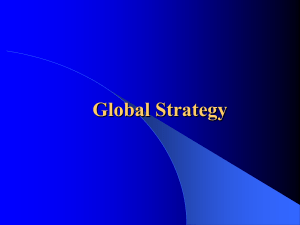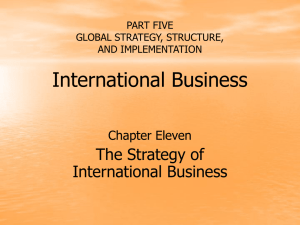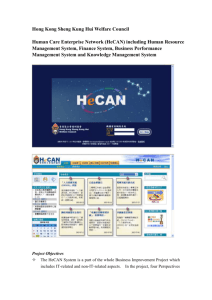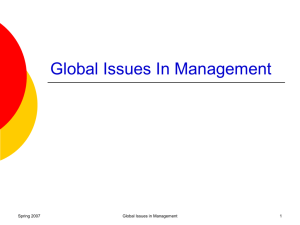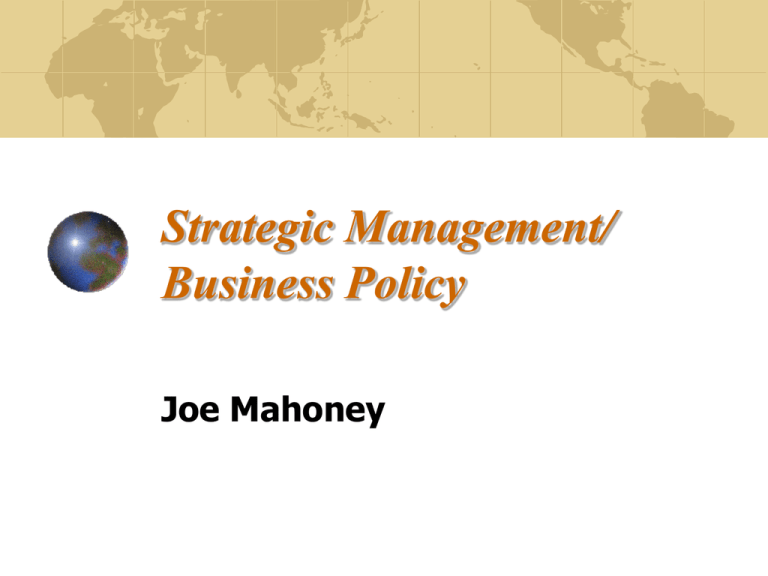
Strategic Management/
Business Policy
Joe Mahoney
Questions About Global Competition
What is an international strategy?
What is the value of global strategies?
Why are some countries more competitive
than others in global competition?
How do companies diversify internationally?
How do you organize a global company?
International Strategy
An international strategy
refers to the selling of products
and markets outside a firm’s
domestic market.
Value of Global Strategies
Gain Access to New Customers for Current
Products or Services
Disneyland Tokyo, EuroDisney
Gain Access to Low-Cost Factors of
Production
Achieving global economies of scale in the
automobile industry
Leverage Core Competencies
E.g., Honda developing and leveraging its
competencies in producing motors for
motorcycles, automobiles, snow blowers and
lawn mowers.
Value of Global Strategies
“Stretching” to Develop New Core
Competencies
E.g., Pepsi Restaurants trying to develop new skills
in upscale casual dining.
Managing Corporate Risk
As global capital markets become more
efficient over time, the benefit provided by
this corporate strategy diminishes.
Theory of Comparative Advantage
David Ricardo: Principles of Political Economy
(1817).
Extends free trade argument
Efficiency of resource utilization leads to more productivity.
Should import even if country is more efficient in the
product’s production than country from which it is buying.
• Look to see how much more efficient. If only comparatively
efficient, than import.
Makes better use of resources
Trade is a positive-sum game.
© McGraw Hill Companies, Inc.,2000
4-11
3-34
The Determinants of National
Competitive Advantage
Intensity
Intensity
of
of
Rivalry
Rivalry
Factor
Conditions
National
Competitive
Advantage
Local
Local
Demand
Demand
Conditions
Conditions
Competitiveness
Competitiveness
of
ofRelated
Relatedand
and
Supporting
SupportingIndustries
Industries
Copyright 1998 by Houghton Mifflin Company. All rights reserved.
4-32
Determinants of
National Competitive Advantage
Chance
Company Strategy,
Structure,
and Rivalry
Two external
factors that
influence the
four
determinants.
Factor
Conditions
Government
McGraw-Hill/Irwin
Demand
Conditions
Related
and Supporting
Industries
© 2003 The McGraw-Hill Companies, Inc., All Rights Reserved.
Four Basic Strategies
8-15
Cost Pressures
High
Global
Strategy
Transnational
Strategy
International
Strategy
Multidomestic
Strategy
Low
Low
High
Pressures for Local Responsiveness
Copyright 1998 by Houghton Mifflin Company. All rights reserved.
Cost Pressures and Pressures for Local 8-16
Responsiveness Facing Caterpillar
Cost Pressures
High
Caterpillar,
Inc.
Low
Low
High
Pressures for Local Responsiveness
Copyright 1998 by Houghton Mifflin Company. All rights reserved.
Corporate-level International Strategies
Global Strategy
Products are standardized across
national markets
Emphasizes economies of scale
Lacks responsiveness to local markets
Requires resource sharing and
coordination across borders
Corporate-level International Strategies
Multi-Domestic Strategy
Decentralized strategy
Products and services tailored to local
markets
Focus on competition in each market
Prominent strategy among European
firms due to broad variety of cultures
and markets in Europe
Corporate-level International Strategies
Transnational Strategy
Seeks to achieve both global efficiency and
local responsiveness
Difficult to achieve because of
simultaneous requirements for strong
central control and coordination to achieve
efficiency and local flexibility and
decentralization to achieve local market
responsiveness.
Advantages And Disadvantages of the International Strategies
Strategy
Global
International
Multidomestic
Transnational
Advantages
Experience-curve
Location economies
Low Risk & Cost
Good for firms just
going int’l
Customization of
Products to local
needs
Disadvantages
Lack of
responsiveness
Low Learning &
Scale Effects
Low Responsiveness
Low Learning &
Scale Effects
Low transfer of Core
Compentencies
Combines benefits of Costly
Global and
Implementation
Multidomestic
Costly Management
How Should We Enter A Foreign Country?
Entry Mode
Exporting
Advantages
High Experience &
Location Economies
Licensing
Low entry costs
Franchising
Low entry costs
Joint Ventures
Sharing of costs &
knowledge
Political Risk
High Learning
Protection of Tech.
High coordination
Wholly Owned
Subsidiaries
Disadvantages
Transport Costs
Trade Barriers
Agency
Low control
Low learning
Low coordination
Low control
Low coordination
Low control
Diffusion of
knowledge
High costs & risks
Cooperative Strategies
Strategic alliances are
partnerships between firms
whereby their resources,
capabilities, and core competencies
are combined to pursue mutual
interests in designing,
manufacturing, or distributing
goods or services.
Types of Corporate-Level Strategic Alliances
Diversifying Alliances
e.g., Samsung Group joins with Nissan to
build new automobiles
Synergistic Alliances
e.g., Sony shares development with many
small firms
Franchising
e.g., McDonald’s or Century 21
Cooperative Strategies
Franchising is an alternative
to diversification that is
considered a cooperative
strategy based on a contractual
relationship.
Cooperative Strategies
A network strategy is the
alliance-related actions taken by
a group of interrelated and
comparable firms to serve the
common interests of all
partners.

